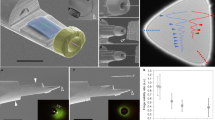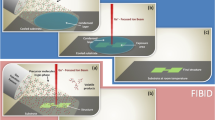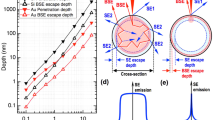Abstract
Electron sources in the form of one-dimensional nanotubes and nanowires are an essential tool for investigations in a variety of fields, such as X-ray computed tomography, flexible displays, chemical sensors and electron optics applications. However, field emission instability and the need to work under high-vacuum or high-temperature conditions have imposed stringent requirements that are currently limiting the range of application of electron sources. Here we report the fabrication of a LaB6 nanowire with only a few La atoms bonded on the tip that emits collimated electrons from a single point with high monochromaticity. The nanostructured tip has a low work function of 2.07 eV (lower than that of Cs) while remaining chemically inert, two properties usually regarded as mutually exclusive. Installed in a scanning electron microscope (SEM) field emission gun, our tip shows a current density gain that is about 1,000 times greater than that achievable with W(310) tips, and no emission decay for tens of hours of operation. Using this new SEM, we acquired very low-noise, high-resolution images together with rapid chemical compositional mapping using a tip operated at room temperature and at 10-times higher residual gas pressure than that required for W tips.
This is a preview of subscription content, access via your institution
Access options
Subscribe to this journal
Receive 12 print issues and online access
$259.00 per year
only $21.58 per issue
Buy this article
- Purchase on Springer Link
- Instant access to full article PDF
Prices may be subject to local taxes which are calculated during checkout




Similar content being viewed by others
References
Ghosh, P. et al. Transparent and flexible field electron emitters based on the conical nanocarbon structures. J. Am. Chem. Soc. 132, 4034–4035 (2010).
Choi, W. et al. Fully sealed high brightness carbon nanotube field emission display. Appl. Phys. Lett. 75, 3129–3131 (1999).
Sugie, H. et al. Carbon nanotubes as electron source in an x-ray tube. Appl. Phys. Lett. 78, 2578–2580 (2001).
Lee, Y. et al. Carbon nanotube based x-ray sources: applications in pre-clinical and medical imaging. Nucl. Instrum. Meth. A 648, S281–S283 (2011).
Modi, A., Koratkar, N., Lass, E., Wei, B. & Ajayan, P. Miniaturized gas ionization sensors using carbon nanotubes. Nature 424, 171–174 (2003).
Sadeghian, R. & Islam, M. Ultralow voltage field ionization discharge on whiskered silicon nanowires for gas-sensing applications. Nature Mater. 10, 135–140 (2011).
de Jonge, N., Lamy, Y., Schoots, K. & Oosterkamp, T. High brightness electron beam from a multi-walled carbon nanotube. Nature 420, 393–395 (2002).
Houdellier, F., Masseboeuf, A., Monthioux, M. & Hytch, M. New carbon cone nanotip for use in a highly coherent cold field emission electron microscope. Carbon 50, 2037–2044 (2012).
de Jonge, N., Allioux, M., Oostveen, J., Teo, K. & Milne, W. Optical performance of carbon nanotube electron sources. Phys. Rev. Lett. 94, 186807 (2005).
Yeong, K. & Thong, J. Life cycle of a tungsten cold field emitter. J. Appl. Phys. 99, 104903 (2006).
Kasuya, K., Katagiri, S. & Ohshima, T. Stabilization of a tungsten <310> cold field emitter. J. Vac. Sci. Technol. B 28, L55–L60 (2010).
Schwind, G., Magera, G. & Swanson, L. Comparison of parameters for schottky and cold field emission sources. J. Vac. Sci. Technol. B 24, 2897–2901 (2006).
Intaraprasonk, V., Xin, H. & Muller, D. Analytic derivation of optimal imaging conditions for incoherent imaging in aberration corrected electron microscopes. Ultramicroscopy 108, 1454–1466 (2008).
Pennycook, S. & Nellist, P. Scanning Transmission Electron Microscopy (Springer, 2011).
Krivanek, O. et al. Atom by atom structural and chemical analysis by annular dark field electron microscopy. Nature 464, 571–574 (2010).
Ahmed, H. & Broers, A. Lanthanum hexaboride electron emitter. J. Appl. Phys. 43, 2185–2192 (1972).
Uijttewaal, M., Wijs, G. & Groot, R. Ab initio and work function and surface energy anisotropy of LaB6 . J. Phys. Chem. B 110, 18459–18465 (2006).
Futamoto, M., Hosoki, S., Okano, H. & Kawabe, U. Field emission and field ion microscopy of lanthanum hexaboride. J. Appl. Phys. 48, 3541–3546 (1977).
Nagata, H., Harada, K. & Shimizu, R. Thermal field emission observation of single crystal LaB6 . J. Appl. Phys. 68, 3614–3618 (1990).
Zhang, H. et al. Nanostructured LaB6 field emitter with lowest apical work function. Nano Lett. 10, 3539–3544 (2010).
Zhang, H., Zhang, Q., Tang, J. & Qin, L. Single crystalline LaB6 nanowires. J. Am. Chem. Soc. 127, 2862–2863 (2005).
Zhang, H. et al. Field emission of electrons from single LaB6 nanowires. Adv. Mater. 18, 87–91 (2006).
Brewer, J., Deo, N., Wang, Y. & Cheung, C. Lanthanum hexaboride nanoobelisks. Chem. Mater. 19, 6379–6381 (2007).
Amin, S., Li, S., Roth, J. & Xu, T. Single crystalline alkaline earth metal hexaboride one dimensional (1D) nanostructures: synthesis and characterization. Chem. Mater. 21, 763–770 (2009).
Fujita, S. Electron gun technologies for high resolution electron microscopes. J. Vac. Soc. Jpn 55, 64–72 (2012).
Fursey, G. Field Emission In Vacuum Microelectronics (Kluwer Academic, 2005).
Qian, W., Scheinfein, M. & Spence, J. Brightness measurement of nanometer sized field emission electron sources. J. Appl. Phys. 73, 7041–7045 (1993).
de Jonge, N. et al. Characterization of the field emission properties of individual thin carbon nanotubes. Appl. Phys. Lett. 85, 1607–1609 (2004).
Nishitani, R. et al. Surface structures and work functions of the LaB6 (100), (110) and (111) clean surfaces. Sur. Sci. 93, 535–549 (1980).
Bronsgeest, M., Barth, J., Swanson, L. & Kruit, P. Probe current, probe size, and the practical brightness for probe forming systems. J. Vac. Sci. Technol. B 26, 949–955 (2008).
Swanson, L. & Schwind, G. A review of the cold field electron cathode. Adv. Imag. Elect. Phys. 159, 63–98 (2009).
Orloff, J. Handbook of charged particle optics (CRC Press, 2009).
Chang, C., Kuo, H., Hwang, I. & Tsong, T. A fully coherent electron beam from a noble metal covered W(111) single atom emitter. Nanotechnology 20, 115401 (2009).
Oshima, C., Rokuta, E., Itagaki, T., Ishikawa, T. & Cho, B. Demountable single atom electron source. e-J. Surf. Sci. Nanotech. 3, 412–416 (2005).
Swanson, L. & Martin, N. Field electron cathode stability studies: zirconium/tungsten thermal field cathode. J. Appl. Phys. 46, 2029–2050 (1975).
Toda, Y. et al. Work function of a room temperature stable electride [Ca24Al28O64]4+(e−)4 . Adv. Mater. 19, 3564–3569 (2007).
Zhou, Y. et al. A universal method to produce low work function electrodes for organic electronics. Science 336, 327–332 (2012).
Acknowledgements
This work was partially supported by the Development of System and Technology for Advanced Measurement and Analysis, Japan Science and Technology Corporation (JST) and the Nanotechnology Network Project of the Ministry of Education, Culture, Sports, Science, and Technology (MEXT), Japan. The authors also wish to thank Hitachi High-Technologies Corporation for assistance in this project.
Author information
Authors and Affiliations
Contributions
H.Z., J.T. and L.C.Q. conceived the idea of the study and performed data analysis. H.Z. carried out the main experiments. H.Z., J.T. and L.C.Q. wrote the manuscript. J.T. supervised the project. J.Y. participated in component fabrication. Y.Y. participated in component design and result analysis. T.T.S. participated in the electron energy analyser construction. K.N. carried out electron/ion beam fabrication. N.S. participated in data analysis.
Corresponding authors
Ethics declarations
Competing interests
The authors declare no competing financial interests.
Supplementary information
Supplementary information
Supplementary Information (PDF 1424 kb)
Rights and permissions
About this article
Cite this article
Zhang, H., Tang, J., Yuan, J. et al. An ultrabright and monochromatic electron point source made of a LaB6 nanowire. Nature Nanotech 11, 273–279 (2016). https://doi.org/10.1038/nnano.2015.276
Received:
Accepted:
Published:
Issue Date:
DOI: https://doi.org/10.1038/nnano.2015.276
This article is cited by
-
Artificial-intelligence-assisted mass fabrication of nanocantilevers from randomly positioned single carbon nanotubes
Microsystems & Nanoengineering (2023)
-
Femtosecond tunable-wavelength photoassisted cold field emission
Applied Physics B (2023)
-
High-endurance micro-engineered LaB6 nanowire electron source for high-resolution electron microscopy
Nature Nanotechnology (2022)
-
Ultrafast electron cooling in an expanding ultracold plasma
Nature Communications (2021)
-
Enhanced field emission performance of growth-optimized CuO nanorods
Applied Physics A (2021)



